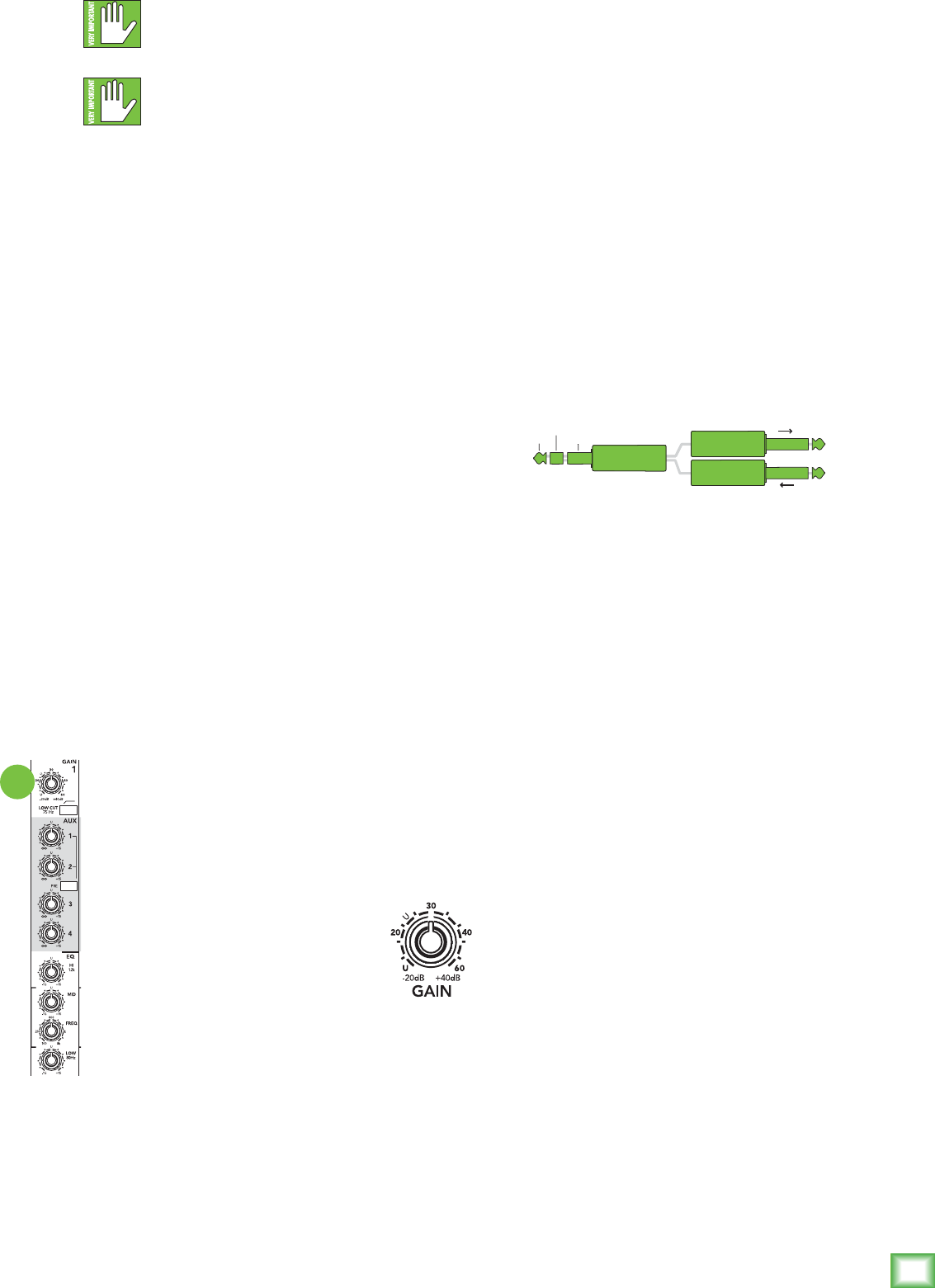
9
Owner’s Manual
Owner’s Manual
1. Mic Ins
ThisisafemaleXLRconnectorthatacceptsa
balancedmicorlinelevelinputfromalmostanytype
ofsource.TheseOnyxmicpreampsfeaturehigher
delityandheadroomrivalinganystandalonemic
preamponthemarkettoday.These circuits are
excellentatrejectinghumandnoise.
TheXLRinputsarewiredasfollows:
Pin 1 = Shield or ground
Pin2=Positive(+orhot)
Pin3=Negative(–orcold)
Professionalribbon,dynamic,andcondensermicsall
soundexcellentthroughtheseinputs.Themic/line
inputswillhandleanykindoflevelyoucantossat
them,withoutoverloading.
Noteveryinstrumentismadetoconnectdirectlyto
amixer.GuitarscommonlyneedaDirectInjection(DI)
boxtoconnecttothemixer'smicinputs.Theseboxes
convertunbalancedline-levelsignalsfromyourguitar,
intobalancedmic-leveloutputs,andprovidesignaland
impedancematching.Theyalsoletyousendyourgifted
guitarrenditionsoverlongcablesoraudiosnakes,
withminimuminterferenceorhigh-frequencysignal
loss.Askyourdealerorguitarmakerabouttheir
recommendationsforagoodDIbox.
Phantom Power
Mostmodernprofessionalcondensermicsare
equippedforphantompower,whichletsthemixer
sendlow-currentDCvoltagetothemic’selectronics
throughthesamewiresthatcarryaudio.(Semi-pro
condensermicsoftenhavebatteriestoaccomplishthe
samething.)“Phantom”owesitsnametoanabilityto
be“unseen”bydynamicmics(ShureSM57/SM58,for
instance),whichdon’tneedexternalpowerandaren’t
affectedbyitanyway.
The1642VLZ4’sphantompowerisgloballycontrolled
bythephantom[22]switchontherearpanel.
(Thismeansthephantompowerforallchannels
isturnedonandofftogether.)
TheGAINcontrolsforstereochannels9-10and11-12
areonlyusedtoadjusttheMicinputs.Thelineinputs
are set to unity gain.
TheGAINcontrolsforchannels13-14and15-16only
adjusttheline-levelinputs,astheyhavenoMicinputs.
4. Insert
Foundonlyonchannels1–8,theseunbalanced1/4"
jacksareforconnectingserialeffectsprocessorssuch
ascompressors,equalizers,
de-essers,orlters.Theinsertpointisafterthegain
[3]control,butbeforethechannel’sEQ[32],lowcut
[34],fader[25]andmute[30]controls.Insertcables
mustbewiredthusly:
Tip=send(outputtoeffectsdevice)
Ring = return(inputfromeffectsdevice)
Sleeve = commonground
Eventhoughchannels1–8alreadyhavedirectout[5]
jacks,insertjackscanalsobeusedaschanneldirect
outputs;post-gain,pre-lowcut,andpre-EQ.Seethe
connector section on page 27 showing three ways to use
insert cables.
tip
This plug connects to one of the
mixer’s Channel Insert jacks.
ring
tip
ring
sleeve
SEND to processor
RETURN from processor
(TRS plug)
Neverplugsingle-ended(unbalanced)
microphones,orribbonmicsintothemic
inputjacksifthephantompowerison.
Donotpluginstrumentoutputsintothe
micinputjackswithphantompoweron
unlessyouknowforcertainitissafetodoso.
2. Line Ins
These1/4"jackssharecircuitry(butnotphantom
power)withthemicpreamps,andcanbedrivenby
balancedorunbalancedsourcesatalmostanylevel.
Youcanusetheseinputsforvirtuallyanysignalyou’ll
comeacross,frominstrumentlevelsaslowas–50dBto
operatinglevelsof–10dBVto+4dBu,asthereis45dB
ofgainavailableviathegain[3]knob.Notethat
channels1-8lineinputsareintiallyattenuatedby
15dB.Alwaysmakesuretoperformthelevelsetting
procedureonpage5.
Tolearnhowsignalsareroutedfromtheseinputs,
see the details lovingly described in the channel strip
section.
Toconnectbalancedlinestotheseinputs,use
a1⁄4"Tip-Ring-Sleeve(TRS)plug,wiredasfollows:
Tip=Positive(+orhot)
Ring=Negative(–orcold)
Sleeve = Shield or ground
Toconnectunbalancedlinestotheseinputs,
usea1⁄4"mono(TS)phoneplug,wiredasfollows:
Tip=Positive(+orhot)
Sleeve = Shield or ground
3. Gain
Thesecontrolsarenotinthepatchbay,but
theyarethetoprowofknobsinthechannelstrip
section.(Theyaresovitallylinkedwiththeinputs,
thisseemedlikeagoodplacetodescribethem.)
Ifyouhaven’talready,pleasereadthelevel-setting
procedureonpage5.
Gainadjuststheinputsensitivityof
themicandlineinputs.Thisallows
signalsfromtheoutsideworldtobe
adjustedtooptimalinternaloperating
levels.
IfthesignaloriginatesthroughtheXLRjack,there
willbe0dBofgainwiththeknobfullydown,ramping
to60dBofgainfullyup.
Throughthe1⁄4"input,thereis20dBofattenuation
fullydownand40dBofgainfullyup,witha“U”(unity
gain)markat10:00.This20dBofattenuationcanbe
veryhandywhenyouareinsertingaveryhotsignal,or
whenyouwanttoaddalotofEQgain,orboth.Without
this“virtualpad,”thisscenariomightleadtochannel
clipping.
3


















